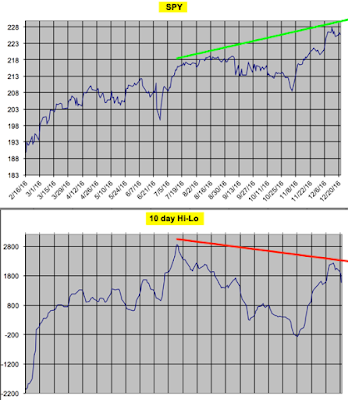Chart In Focus, by Tom McClellan
The Market, Under a New President
November 10, 2016
Investors get fearful ahead of a big election, because the outcome is
unknown. Unknown risks are what investors fear most. Now that the
result is decided, we have known risks to deal with.
Investors were also fearful ahead of the 2012 election, which also had a
surprising (for some) result. Recall that Gov. Romney had been up by
1-4% in the last polls leading up to that election. Polling that year
was admittedly disrupted by the arrival of Hurricane Sandy, which also
shut down the stock market for 2 days.
And interestingly, the market now is doing a pretty good imitation of
the path of price movements 4 years ago. In 2012 there was a dip into
mid-November after the Nov. 6 election. This time it was a dip the week
before the Nov. 8 election. But in each case there has also been a
strong rebound after that dip.
You may have heard before that having a Democrat president is better
for the stock market than having a Republican president, and there are
statistics which can be used to support that. In the following chart,
the averages for each category since 1933 are plotted:
The real truth is a lot more nuanced than just saying one is better
than the other. On average, the market has performed better for the
first 16 months of Democrats’ terms, but then by the 3rd year that advantage completely disappears. And market performance in the 4th
year is worse on average under a Republican president. A big part of
that is the weakness after the Oct. 1987 crash, and from the 2008 bear
market, both of which happened under Republican presidents.
Another differentiation among presidents concerns whether there is a new president from a different party, versus a 2nd
term president or a new one from the same party. This one is a much
bigger deal, especially during the first year of a new presidential
term.
Generally speaking, investors respond more favorably at first to
getting a new president from a different party. This has to do with
celebrating that they got the change they wanted (or so they think).
That positive emotion tends to wear off right around inauguration day,
when they realize that the new president has not fixed all of the
problems already.
The negativity under a new president persists as the year runs on,
because of a habit they all seem to have. I have seen this same
behavior repeatedly over my lifetime. A new president comes in, and
spends his first year “discovering” that conditions are even worse than
we were told during the campaign, and then tells us that “the only
solution” is whatever package of tax hikes/cuts or spending adjustments
he wants to make.
Bill Clinton did this in 1993. Despite 5% GDP growth then, Clinton
asserted that “This is the worst recession in 50 years,” and he wanted
to jam through a $20 billion package of pork barrel spending (mostly to
reward campaign contributors). Congress wisely said no. When I think
back on that, I realize that $20 billion is such a cute little number
compared to the size of the “fixes” that have come since then.
With Bush 43 in 2001, it was tax cuts, although he could not get all he
wanted right away and had to do another round in 2003. With Barack
Obama in 2009, it was the American Recovery and Reinvestment Act, with
$831 billion in stimulus spending (see why $20 billion is a cute little
number)? They all seem to do it.
Investors generally don’t like hearing that things are worse than
previously believed, and that creates a depressing effect on stock
prices during a first year. Generally speaking, 2nd term
presidents do not spend very much time blaming the immediate
predecessor, or finding things wrong, and so investors don’t get
frightened away as much. But as noted previously, that difference in
stock market performance between 1st and 2nd term presidents generally goes away by the end of the 2nd year.
Every instance is different, and these charts just show what the average behavior has been.
Keep following JustSignals using Twitter, @StockTwits or Follow By Email.
Just submit your email address in the box on the Blog homepage
This
has been posted for Educational Purposes Only. Do your own work and
consult with Professionals before making any investment decisions.
Past performance is not indicative of future results



































